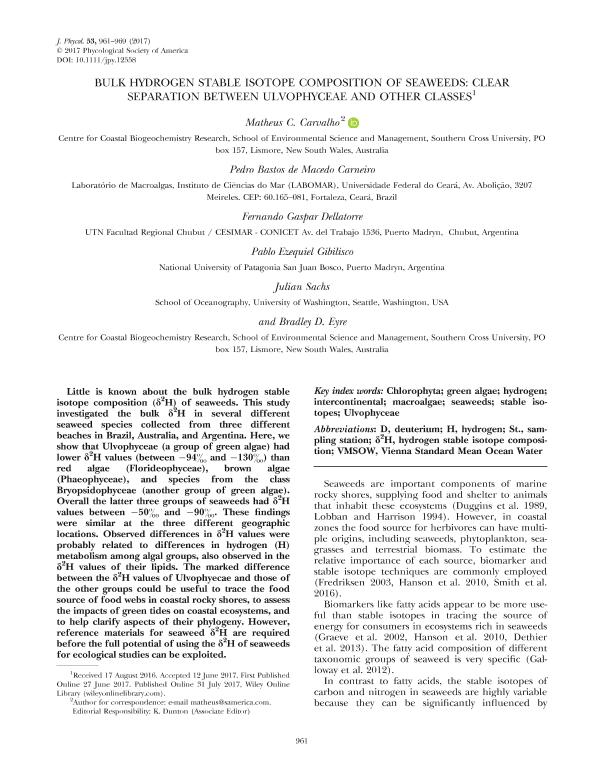Artículo
Bulk hydrogen stable isotope composition of seaweeds: Clear separation between Ulvophyceae and other classes
Carvalho, Matheus C.; Carneiro, Pedro Bastos de Macedo; Dellatorre, Fernando Gaspar ; Gibilisco, Pablo Ezequiel
; Gibilisco, Pablo Ezequiel ; Sachs, Julian; Eyre, Bradley D.
; Sachs, Julian; Eyre, Bradley D.
 ; Gibilisco, Pablo Ezequiel
; Gibilisco, Pablo Ezequiel ; Sachs, Julian; Eyre, Bradley D.
; Sachs, Julian; Eyre, Bradley D.
Fecha de publicación:
10/2017
Editorial:
Wiley Blackwell Publishing, Inc
Revista:
Journal Of Phycology
ISSN:
0022-3646
Idioma:
Inglés
Tipo de recurso:
Artículo publicado
Clasificación temática:
Resumen
Little is known about the bulk hydrogen stable isotope composition (δ2H) of seaweeds. This study investigated the bulk δ2H in several different seaweed species collected from three different beaches in Brazil, Australia, and Argentina. Here, we show that Ulvophyceae (a group of green algae) had lower δ2H values (between −94? and −130?) than red algae (Florideophyceae), brown algae (Phaeophyceae), and species from the class Bryopsidophyceae (another group of green algae). Overall the latter three groups of seaweeds had δ2H values between −50? and −90?. These findings were similar at the three different geographic locations. Observed differences in δ2H values were probably related to differences in hydrogen (H) metabolism among algal groups, also observed in the δ2H values of their lipids. The marked difference between the δ2H values of Ulvophyecae and those of the other groups could be useful to trace the food source of food webs in coastal rocky shores, to assess the impacts of green tides on coastal ecosystems, and to help clarify aspects of their phylogeny. However, reference materials for seaweed δ2H are required before the full potential of using the δ2H of seaweeds for ecological studies can be exploited.
Archivos asociados
Licencia
Identificadores
Colecciones
Articulos(CESIMAR)
Articulos de CENTRO PARA EL ESTUDIO DE SISTEMAS MARINOS
Articulos de CENTRO PARA EL ESTUDIO DE SISTEMAS MARINOS
Citación
Carvalho, Matheus C.; Carneiro, Pedro Bastos de Macedo; Dellatorre, Fernando Gaspar; Gibilisco, Pablo Ezequiel; Sachs, Julian; et al.; Bulk hydrogen stable isotope composition of seaweeds: Clear separation between Ulvophyceae and other classes; Wiley Blackwell Publishing, Inc; Journal Of Phycology; 53; 5; 10-2017; 961-969
Compartir
Altmétricas



